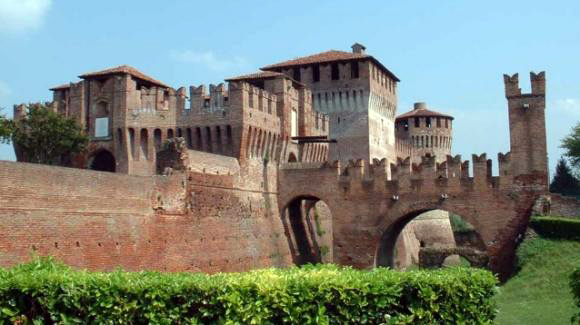Cremona is one of twelve provinces within in the Lombardy region of Italy. It is located along the central section of the Padana Plain, so unusual for Italy, it is very flat, without mountains or hills. The river Po, Italy’s longest river, is the natural boundary with the adjoining province of Piacenza, while the Oglio separates the province from Brescia.
The entire area has been occupied since the Stone Age, while Rome’s sphere of influence began in the third century BC. Under Roman rule, the area that is now Cremona, as well as much of the surrounding region, became one of the richest and most-developed areas in Italy. That sense of commercial purpose is still very much in evidence. Agriculture remains a major industry. Over the centuries, many canals were dug for irrigation purposes and rice is the biggest crop in the area. Although grapes are cultivated and wine produced, it is far down on the list of provinces with vineyards to visit; in fact, you are likely to find more dairy cows than grape vines. The cheeses from the province are superb. The most popular varieties are Gorgonzola, Taleggio and Grana Padano, but the most unusual flavors are found in its Provolone Valpadana and Salva Cremasco. It is also in Cremona where the famous nougat torrone originated. This confection was first made in the year 1441, in celebration of the marriage of Bianca Maria Visconti and Francesco Sforza. Since this is the region of Lombardy, one of the other culinary specialties is mostarda, but unlike most other places which prepare the condiment using sliced fruit, in Cremona, the mostarda is made from whole oranges, apricots and cherries. The fruit is candied and then infused with mustard oil. It is traditional to enjoy mostarda with cheese. When paired with Grana Padano, the blend is a symphony of flavors. When paired with the feisty Taleggio, the explosion of flavors are like fireworks!
Cremona’s virtue lies in how far off the tourist path it remains. Away from the farms, you will find the city of Cremona to be a small, well-kept, mercantile city. It is quite appealing to the eye, but unlike Bologna, there is no city university; unlike Rome, there are no grandiose must-see sights. Instead, Cremona is famous for something even more universal – music. Its history is inexorably intertwined with violins and other stringed instruments. The cathedral, built in the 12th century, provided a focus for musical activity and by the 16th century, the town was the musical center of the region. Even now it attracts people to hear performances by ensembles and to attend its many festivals.
The reason for its fame in the musical world is that nowhere else were violins made with the skill, precision and lasting tone of those from Cremona. The Cremonese method dates back to the 16th century, with the father of the violin, Andrea Amati. The process and crafting requires a host of skills: extraordinary dexterity, a keen eye for detail, a finely-tuned ear for pitch, as well as a knowledge of woods, glues and varnishes. The result is an instrument that can most closely reproduce the tonal subtleties of a human voice. The method took longer and was more difficult than other ones, but it created one-of-a-kind instruments. The method was refined by the Guarneri family in the 17th century and then by the Stradivari family, particularly Antonio Stradivari, whose violins, violas, cellos and other stringed instruments have risen to near mythic status and stratospheric prices. Stradivari built his instruments from the inside out, using an inner form. He selected spruce for the tops, willow for the internal blocks and linings and maple for the back, ribs and neck. This is a practice followed to this day in the industry. His instruments were varnished using Cremonese resin, oil and a natural pigment for color. Instruments made during Stradivari’s “golden period” from 1700 to about 1725, are worth millions of dollars. In 2011, his “Lady Blunt” violin from 1721 (which is in pristine condition) was sold in London for $15.9 million.
More than 140 liutaio currently ply their trade in the city. Wandering the narrow streets around the Piazza del Comune, you can watch dozens of violinmakers at their workbenches through their storefront windows. If they’re not too busy, some will wave for you to come inside to have a look. Perhaps what is most remarkable is that in this age of technology, nothing about the creation of a fine violin has changed for centuries. It is true that the instrument can be mass produced using computer models and machinery, but the result lacks an intangible quality. The liutaio call it the cuore e anima- heart and soul.
The “traditional violin craftsmanship in Cremona” was declared an intangible cultural heritage by UNESCO in 2012. The following year, the impressive, high-tech Museo del Violino opened in the city center, financed by more than 10 million euros from the local steel magnate Giovanni Arvedi. A few blocks away sits the Academia Cremonensis. Set in a beautiful grand palazzo, the academy teaches the Cremonese method, as well as bow-making to students from around the world. Additionally, the city’s museum, the Museo Civico, boasts a priceless collection of stringed instruments, while Casa Stradivari is the former family home of the famed violin-maker. It is run by an association of violin-makers who often put on exhibitions.
These features make Cremona a must-visit for music lovers, but it is also a perfect overnight side trip from Milan. This fall, Cremona will be buzzing about the 15th Triennale Violin-making Competition. This event is essentially the Olympics of stringed instruments and takes place September 7 to October 14, overlapping the city’s annual Stradivari Festival.
But even those without a passion for stringed instruments can look forward to excellent food, impressive architecture and a city that is almost completely off the tourism radar. Cremona has one of the most beautiful piazzas in northern Italy. Twelve streets converge on the haunting Piazza del Comune, marked by its majestic 14th century, 367-foot-tall bell tower called simply, the Torrazzo – for which torrone nougat is named.
The Gothic palazzi and the Romanesque cathedral cut dramatic shadows against the arcades and the octagonal 12th century baptistery is an architectural gem. The 268-year-old Teatro Ponchielli has one of the largest stages in Italy and is still a magnet for international performances. The sprawling markets in the Piazza Stradivari and Piazza Pace are as lively as any in Lombardy, making this province one of the undiscovered gems of northern Italy.





